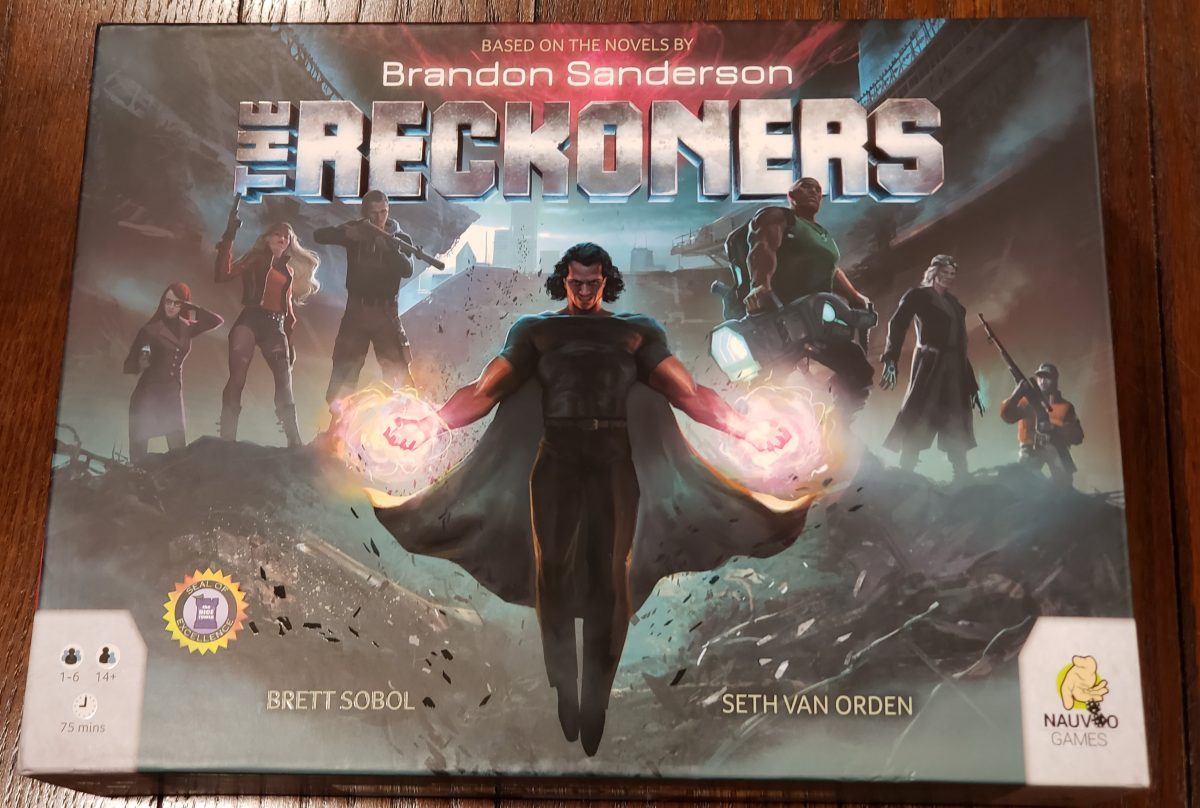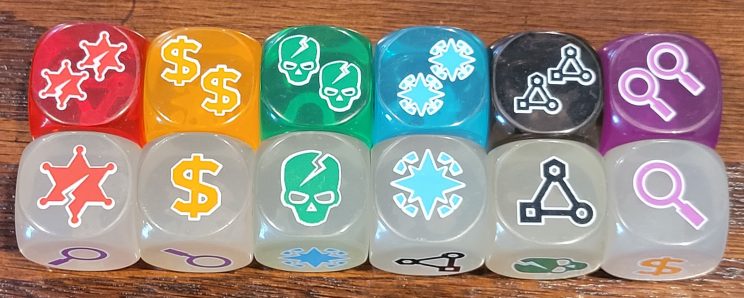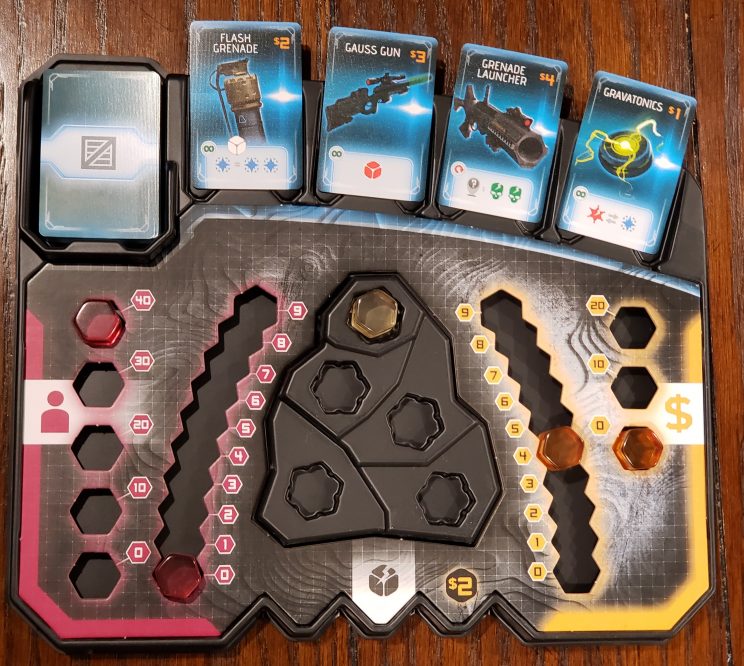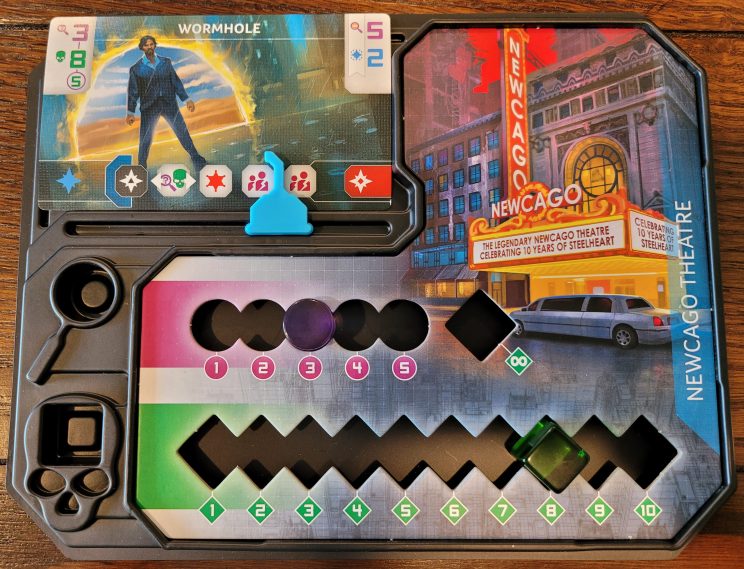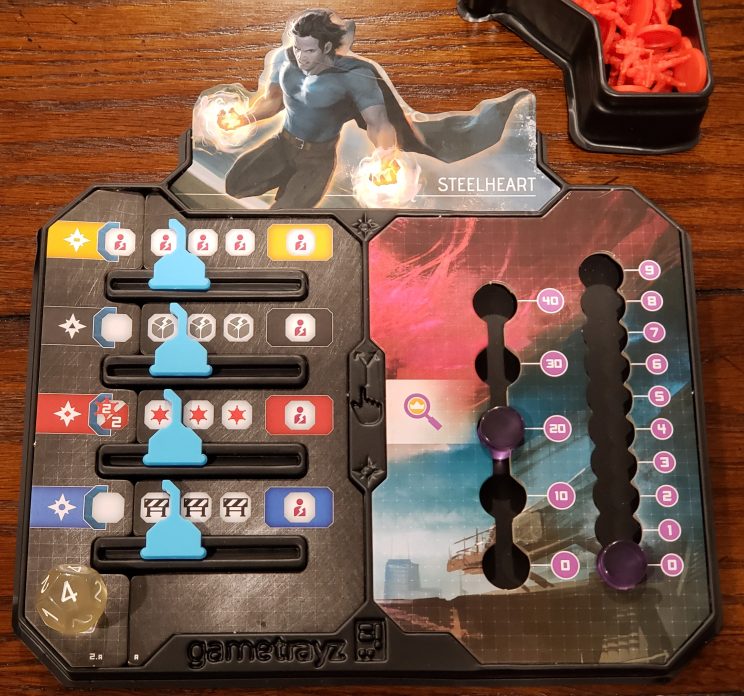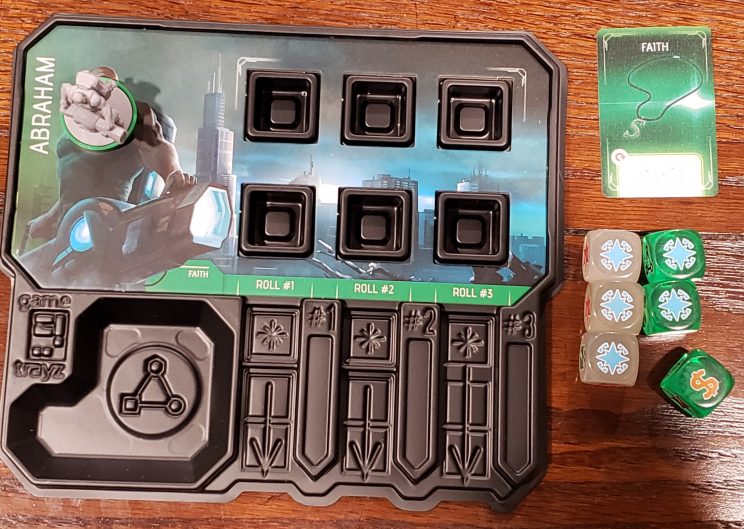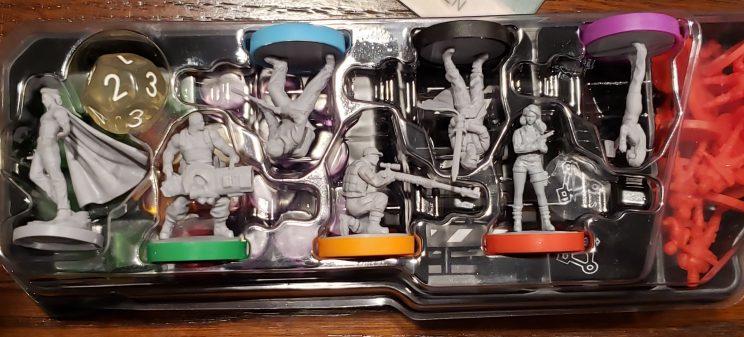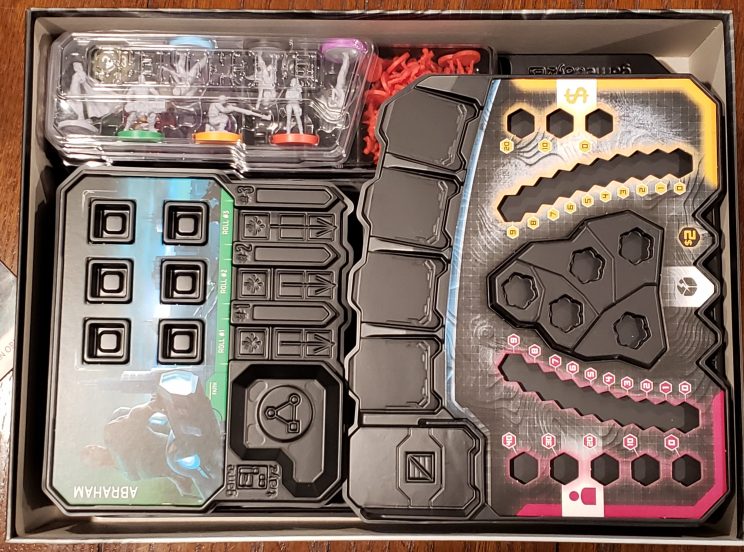The Reckoners
I made a decision when I started this website to run content about board games and books. The pandemic pretty much shut down any hope of playing board games in person for a long time. While I wholeheartedly support digital board game adaptations, I only had a few rare opportunities to play these during the pandemic and, like so many others, my emotional and physical energies were focused on other things.
Now that the vaccines are rolling out and board game meetups are resuming (please get vaccinated, folks!), I have been able to play some of the games I have been wanting to table since February 2020. The first one on decks is The Reckoners, a 1-6 player cooperative dice-rolling game based thematically on Brandon Sanderson’s best-selling young-adult novel series by the same name (the first book is Steelheart).
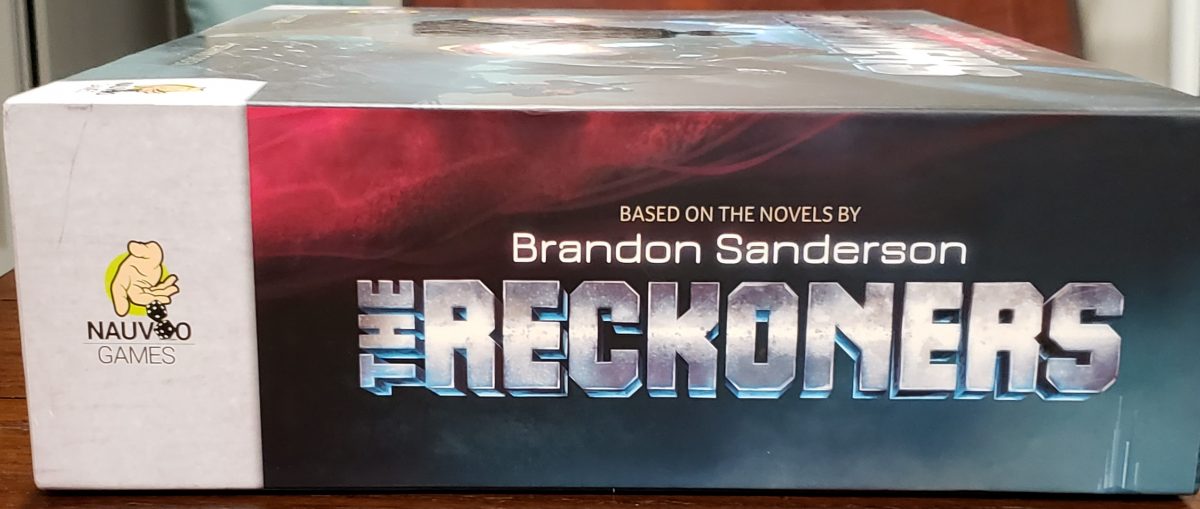
Theme
The Reckoners is loosely based on the series of three young-adult novels by Brandon Sanderson: Steelheart, Firefight, and Cataclysm. The game is set in a post-apocalyptic, dystopian version of Chicago (called Newcago), where super-powered villains (Epics) have seized control of the city from the population. The Players take on the role of the Reckoners, a group of rebels fighting to free the city from the Epics and save the citizens of Newcago. Each Reckoner is particularly good at one of the actions available in the game and their special ability aligns thematically with the books.
Sanderson’s books provide a large canvas of Epics and their powers, even though only perhaps a dozen ever become major players in the series. Therefore, The Reckoners game ultimately presents a much more broad slate of Epics than readers of the book would expect. In the cases where the Epics clearly overlap, the powers assigned to them seem thematically in line with the books. While the game is not canon for the world of Newcago (for reasons set out below), it is nice to see some of the more obscure and esoteric Epics get a power set assigned to them.
The Reckoners deviates from the book series in fundamental ways. This was an active decision during the development of the game to preserve the twists and the climax of the books for anyone who would be introduced to this world by playing the game. The Reckoners contains no spoilers for events that occur in the books!
Mechanics
The Reckoners is a dice-rolling cooperative game for between 1 and 6 players. The box says gameplay should take around 75 minutes; however, from my personal experience, the game appears to take between 15-30 minutes per player and can take up to 30 minutes to teach, depending on the experience level of your group. The most recent 5-player game I completed took almost 2 hours, but I did teach the game for about 20 minutes before we started. Each turn in the game is made up of 4 phases:
1. Roll the Dice
King of Tokyo rules are in effect for dice-rolling, meaning players can roll up to 3 times, but must retain at least 1 die after each roll. It should be noted that they can stop rolling and retain all dice at any time before the 3rd roll, should they so choose. One key difference between The Reckoners and other cooperative games is that players do not take turns in the traditional sense. All dice-rolling is performed simultaneously and with discussion. Discussing strategy is encouraged at all points of the game.
Each playable character is good at one of the six possible player actions. From left to right in the order they appear above: Remove Enforcement, Earn Money, Damage Epics, Suppress Epics, earn Planning Tokens, and Research Epics.
2. Player Actions
Player actions are decided on as a group and taken in any order the team wants, but there are a few key rules on how dice can be used. For example, through some combination of die faces and/or equipment cards, players may find themselves in possession of a single die face worth 2 or more symbols towards a single action—these must be used for a single action, even if some of the symbols are wasted. Also, players can use any of their die, regardless of the symbols showing to move from one District to an adjacent one or to remove a Barricade anywhere in play. Lastly, Planning Tokens can be used as “wild,” allowing the player to perform an action as though the Token is a single die face of that symbol, or to move or remove a Barricade.
Players have to be physically located in the same District as the Enforcement soldiers they wish to attack or an Epic they wish to attack, suppress, or research. Once all dice have been used, the Player Action phase is over.
3. Buy Equipment
Money in The Reckoners is Communal, and so is deciding how that money is spent. Purchased equipment is assigned to any single player and cannot be shared or traded in later turns. There are no limits to the number of purchases the team can make, so long as they have the money to pay to spend.
The Reckoners’ Base gets its own Tray. The Newcago Population starts at 40 and is tracked by the purple/pink trackers on the left. The communal pool of money is tracked by the yellow/orange markers on the right. The equipment market is along the top of the tray. The white/clear tracker in the center of the tray marks how many times Epics have “searched” for the Reckoner’s base and if the tracker reaches the bottom (lowest) point, the players decide on one die to give up (can be recovered later).
Equipment can range from doubling certain die face symbols, allowing free exchange of one symbol for another, give free movement for that player, or even give a player an extra die to roll during the first phase of each turn.
4. Activate Epics
Much the way the players actions are communal, Epic abilities can be communal. The Epic in control of the District colocated with the Steelheart mini activates first and then activation proceeds clockwise around the board until every Epic has gone. Then Steelheart activates and moves.
Epics activate based on how many of their power symbols are to the left of the moving bracket on the District. Some of their abilities directly effect the players (e.g., kill population or add Enforcement soldiers) or fortify Steelheart (e.g., move Steelheart’s yellow, black, red, or blue bracket by some number of spaces to the right, making him more powerful). After activating, the Epic fortifies, their bracket moving to the right by 1 + the number of Enforcement soldiers on their District.
The health and research value of each Epic is set based on the values on the upper left of their card. Researching an Epic can reduce their health (and may be necessary in the case of “invulnerable” Epics). Defeated Epics give free research against Steelheart and usually one other reward. The blue bracket moves along a track in the District tray and Activating an Epic uses all powers to the left of this bracket.
Steelheart’s activation only occurs after all the other Epics are activated and all of his abilities are directly focused on hampering the players ability to win the game. Steelheart will always kill at least one population and add some number of Enforcement soldiers to play, but depending on the difficulty selected by the players and depending on how fortified he is, he can also “seek the Reckoners’ base” and put Barricade tokens out onto the Districts.
Steelheart is immune until players research his weaknesses. Once the research track (marked by the purple/pink tracker on the right) reaches 0, players remove the overlay and place a green tracker at the starting health for the difficulty the players have chosen. Only after Steelheart is researched can he be damaged. The 12-sided die dictates how far Steelheart moves after activation each turn.
Steelheart and the Epics can “seek the Reckoners’ base” a total of five times before one player (community choice) has to give up a single die. Players can buy all dice captured this way back for $2. Barricades have to be removed from play (by discarding any die or a Planning Token) before any players can move into or out of that District.
Components
The quality of the components in The Reckoners is very high, but that is to be expected given the high MSRP of the game (approximately $100 at launch and runs around $85 regularly these days). The game comes with its own custom GameTrayz system, which some people may find an unnecessary expense, but I honestly am not sure how the game could be played without it—Epic powers, Districts, and the Reckoners’ base all have trackers that would feel much less satisfying if putting a tracker on a flat piece of paperboard or cardboard. Given the amount of component swapping (as Epics are defeated, Steelheart is researched, etc.), trying to remember where tokens went or (God forbid) someone bump the table… Well, it would be a mess. The trays do a good job of preventing the most important items, the trackers and brackets, from shifting from an accidental bump.
The player trays are not as useful as the other trays, but they serve their purpose okay. They have spaces for players to reserve their dice after each roll, places to show played die during the action phase, and a small depression for Planning Tokens.
The miniatures are stylistic and not as highly detailed as some (for example, Gloomhaven), but they are well aligned with the art-style of the game and they reflect the artwork on the player mats well. The sculpts are unique enough that when combined with the colored bases, players can easily tell which represents themselves.
The Enforcement soldiers and barricades feel of a cheaper quality than the miniatures, but they are still better quality than cubes or other styles of tokens often used in other games. New owners of the game will need to put the white/black cross-hatching stickers on the barricades, if I recall correctly. The dice and tracking markers are of what feels like a high quality resin. All of the cards, Epics, and tracking boards are of high quality satin finish and feel like they will hold up for a long time.
All of the GameTrayz fit together well and make it so that the setup and teardown of The Reckoners takes only a few minutes. It should also be noted that, while the included trays double as a game storage system, The Reckoners cannot be stored in any way other than bottom-down. The dice are not secured in their tray, and the trays themselves are thin plastic, which helps with weight, but also has the downside of being structurally weak when compared to more weight, sturdy game storage solutions. I have a strong suspicion that prolonged storage of this game on its side would cause warping or cracking of the trays, and given the price tag, that would be bad news. It would also jumble the dice and other components, making setup a more painful process.
The box is a large, almost Gloomhaven sized 12 inches by 18 inches, but not nearly as deep (approximately 5 inches compared to Gloomhaven at 9 inches or so), so it may not be practical to store this box on its side anyway, but it is certainly worth mentioning, as I know a lot of board game owners prefer to store their boxes on the side to make retrieval easier.
Play
A six-player cooperative game you say? How long will I have to wait between turns? No time at all? I’m in!
The design decision for all players to enact their turn simultaneously, collaboratively, and resolve their actions in any order they choose is not only a time-saver, it is a balance issue. Games of The Reckoners with high player counts can be hard. The most recent game I played resulted in winning with 1 Population remaining in Newcago.
In this game, we ended up in a situation where Tia had nothing but research dice available to her, but using all of them at her current location would be a waste (she only needed 3). She did have a motorcycle (1 free movement per round), but there was a barricade up, so she could sacrifice a die to remove it, but that would decrease the number of research actions she could take on the adjacent Epic by 2 (one of her purple die). Instead, Megan used an action to remove the barricade, letting Tia completely research 2 Epics that round. Both of those Epics were subsequently defeated by a combination of Damage Epic actions taken by Abraham and Cody. While this example could have been resolved if Megan removing the barricade had their turn order prior to Tia, that would rely on luck. Instead, we were able to solve it through tactical thinking and adaptation.
A set turn order would result in something akin to what happens in Harry Potter Hogwarts Battle: players need to avoid over-specialization and invest in a broad swath of card types and actions. Instead, the collaborative turn system used by The Reckoners encourages specialization and team-work. Equipment cards are purchased and given to the team-member where they can do the most good, instead of every team member trying to be a jack of all trades.
The game also doesn’t feel quite as punishing as some cooperative games, where a player gets a turn, then the enemies/environment gets a turn, passing clockwise to the next player. While these games are typically balanced to this mechanic, it can feel bad when the enemy’s actions on another player’s turn directly impacts you and there isn’t anything you can do about it (I’m looking at you, Harry Potter Hogwarts battle).
It should be noted that the game will take longer than the box suggests it will as the player count goes up. I played a few solo games that took between 30 and 45 minutes each (but I was learning the rules while playing). A 2-player game took about an hour. A 5-player game took about 2 hours (keep in mind, this was a teaching game).
Despite the length of the game, everyone was engaged and invested. No one was bored and checking their phones. The Epics operate on proscriptive rules, so their turn tends to be incredibly short and, while their actions are impactful and dangerous to the players from a win/loss perspective, are not usually directly impacting the players ability to make decisions or impact the flow of the game. The sole exemption to this is the Epics ability to steal a die from the players if they successfully find the Reckoners’ base, but since players collaborate to decide which die is temporarily removed from play, even this becomes a tactical decision.
TL;DR
Playing The Reckoners can feel overwhelming at first. There is a lot of iconography, dice, tokens, markers, figures, and locations to explain. The reality is that the game feels much more intuitive than at first glance, especially because collusion and cooperation is so strongly encouraged. This means that each player is not required to hold all of the rules in their head at any given time—the ability to discuss potential actions helps the entire team to solidify the rules and sequences as they play. Players don’t feel like they’re making critical errors early in the game the same way many turn-based cooperative games that limit communication can make them feel.
The emphasis on community discussion and consensus does mean that an Alpha Gamer can try to seize control of the flow of the game and try to play all of the actions. The Reckoners doesn’t really provide any solutions to the Alpha Gamer problem that can plague cooperatives, but the existing solutions (take turns being the “leader” over final say each round, etc.) are still effective.
The game is longer than advertised, but playtime will reduce as players become more confident in the rules and strategies. There are so many different combinations of difficulty settings that, for any number of players, there will always be some challenge. Like all cooperative games, more players seems to add difficulty, but that seems to be a problem for all cooperative games that I have played, so nothing new there.
The price tag might be a bit high for some, but there is a lot of game here and the GameTrayz system included is worth the extra price, in my opinion. I’m someone who typically purchases storage solutions for my more fiddly games anyway, so having one that was literally designed into the gameplay is fantastic. I’d highly recommend The Reckoners for anyone who likes larger cooperative groups.

